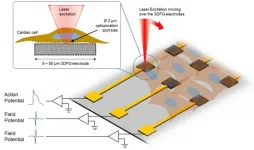Unlocking richer intracellular recordings
CMU/ITT researchers develop novel microelectrode platform to access and record intracellular activity
2021-04-13
(Press-News.org) Behind every heartbeat and brain signal is a massive orchestra of electrical activity. While current electrophysiology observation techniques have been mostly limited to extracellular recordings, a forward-thinking group of researchers from Carnegie Mellon University and Istituto Italiano di Tecnologia has identified a flexible, low-cost, and biocompatible platform for enabling richer intracellular recordings.
The group's unique "across the ocean" partnership started two years ago at the Bioelectronics Winter School (BioEl) with libations and a bar napkin sketch. It has evolved into research published today in Science Advances, detailing a novel microelectrode platform that leverages three-dimensional fuzzy graphene (3DFG) to enable richer intracellular recordings of cardiac action potentials with high signal to noise ratio. This advancement could revolutionize ongoing research related to neurodegenerative and cardiac diseases, as well as the development of new therapeutic strategies.
A key leader in this work, Tzahi Cohen-Karni, associate professor of biomedical engineering and materials science and engineering, has studied the properties, effects, and potential applications of graphene throughout his entire career. Now, he is taking a collaborative step in a different direction, using a vertically-grown orientation of the extraordinary carbon-based material (3DFG) to access the intracellular compartment of the cell and record intracellular electrical activity.
Due to its unique electrical properties, graphene stands out as a promising candidate for carbon-based biosensing devices. Recent studies have shown the successful deployment of graphene biosensors for monitoring the electrical activity of cardiomyocytes, or heart cells, outside of the cells, or in other words, extracellular recordings of action potentials. Intracellular recordings, on the other hand, have remained limited due to ineffective tools...until now.
"Our aim is to record the whole orchestra--to see all the ionic currents that cross the cell membrane--not just the subset of the orchestra shown by extracellular recordings," explains Cohen-Karni. "Adding the dynamic dimension of intracellular recordings is fundamentally important for drug screening and toxicity assay, but this is just one important aspect of our work."
"The rest is the technology advancement," Cohen-Karni continues. "3DFG is cheap, flexible and an all-carbon platform; no metals involved. We can generate wafer-sized electrodes of this material to enable multi-site intracellular recordings in a matter of seconds, which is a significant enhancement from an existing tool, like a patch clamp, which requires hours of time and expertise."
So, how does it work? Leveraging a technique developed by Michele Dipalo and Francesco De Angelis, researchers at Istituto Italiano di Tecnologia, an ultra-fast laser is used to access the cell membrane. By shining short pulses of laser onto the 3DFG electrode, an area of the cell membrane becomes porous in a way, allowing for electrical activity within the cell be recorded. Then, the cardiomyocytes are cultured to further investigate interactions between the cells.
Interestingly, 3DFG is black and absorbs most of the light, resulting in unique optical properties. Combined with its foam-like structure and enormous exposed surface area, 3DFG has many desirable traits that are needed to make small biosensors.
"We have developed a smarter electrode; an electrode that allows us better access," emphasizes Cohen-Karni. "The biggest advantage from my end is that we can have access to this signal richness, to be able to look into processes of intracellular importance. Having a tool like this will revolutionize the way we can investigate effects of therapeutics on terminal organs, such as the heart."
As this work moves forward, the team plans to apply its learnings in large-scale cell/tissue interfaces, to better understand tissue development and toxicity of chemical compounds (e.g. drug toxicity).
INFORMATION:
[Attachments] See images for this press release:

ELSE PRESS RELEASES FROM THIS DATE:
2021-04-13
Slow down. Baby on board.
So says UBC Okanagan researcher and Associate Professor of Mechanical Engineering Hadi Mohammadi. His new research, conducted in collaboration with Sharif University of Technology, determines that accelerating over speed bumps poses a danger for pregnant women and their fetuses.
"There is lots of research about the importance of movement for women during pregnancy," explains Mohammadi, who teaches in the School of Engineering. "Our latest research looked specifically at the impacts of sudden acceleration on a pregnant woman."
Using new modelling based on data from ...
2021-04-13
When the Webster-Kirkwood Times, a community newspaper in the greater St. Louis, Missouri area, had to endure layoffs and stop publishing its print edition -- due to a loss in revenue as a result of the COVID-19 pandemic -- its readers felt the loss and began supporting the newspaper in earnest.
"A lot of times people don't know what they've got until it's gone," said Jaime Mowers, editor-in-chief of the Webster-Kirkwood Times. "Now, there is such a newfound appreciation for the newspaper. It's amazing to have the community's support, knowing we are loved that much and appreciated enough to ...
2021-04-13
BUFFALO, N.Y. - Mindfulness is big business. Downloads of mindfulness apps generate billions of dollars annually in the U.S., and their popularity continues to rise. In addition to what individual practitioners might have on their phones, schools and prisons along with 1 in 5 employers currently offer some form of mindfulness training.
Mindfulness and meditation are associated with reducing stress and anxiety, while increasing emotional well-being. Plenty of scholarship supports these benefits. But how does mindfulness affect the range of human behaviors -- so-called prosocial behaviors -- that can potentially help or benefit other people? What happens when the research looks outwardly at social effects of mindfulness rather than inwardly at its personal effects?
It's ...
2021-04-13
Human screams signal more than fear and are more acoustically diverse than previously thought, according to a study published April 13th 2021 in the open-access journal PLOS Biology by Sascha Fru?hholz of the University of Zurich, and colleagues. Remarkably, non-alarming screams are perceived and processed by the brain more efficiently than alarming screams.
In nonhuman primates and other mammalian species, scream-like calls are frequently used as an alarm signal exclusively in negative contexts, such social conflicts or the presence of predators or other environmental threats. Humans are also assumed to use screams to signal danger and to scare predators. But humans scream not only when they are ...
2021-04-13
First study to examine suicides occurring around the world during the COVID-19 pandemic finds that - in high-income and upper-middle-income countries - suicide numbers have remained largely unchanged or have declined in the early months of the pandemic, compared with expected levels.
However, the authors stress that governments must remain vigilant as the longer-term mental health and economic effects of the pandemic unfold and be poised to respond if the situation changes.
Study looked at numbers of suicides in 21 countries between 1 April and 31 July 2020 and compared these with trends in the previous one to four years.
A new observational study ...
2021-04-13
Screaming can save lives. Non-human primates and other mammalian species frequently use scream-like calls when embroiled in social conflicts or to signal the presence of predators and other threats. While humans also scream to signal danger or communicate aggression, they scream when experiencing strong emotions such as despair or joy as well. However, past studies on this topic have largely focused on alarming fear screams.
Humans respond to positive screams more quickly and with higher sensitivity
In a new study, a team at the University of Zurich Department of Psychology led by Sascha Frühholz ...
2021-04-13
Living near a hazardous waste or Superfund site could cut your life short by about a year, reports Hanadi S. Rifai, John and Rebecca Moores Professor of Civil and Environmental Engineering at the University of Houston. The study, published in Nature Communications and based on evaluation of 65,226 census tracts from the 2018 Census, is the first nationwide review of all hazardous waste sites and not just the 1,300 sites on the national priority list managed by the federal government.
The analysis shows a decrease of more than two months in life expectancy for those living near a Superfund site. When coupled with high disadvantage of sociodemographic factors like age, sex, marital status and income, the decrease could be nearly 15 months, ...
2021-04-13
A group of researchers led by Brazilians has used an innovative model to map gaps in the Amazon rainforest and identify factors that contribute to tree mortality. Water stress, soil fertility, and anthropic forest degradation have the most influence on gap dynamics in the world's largest and most biodiverse tropical rainforest, according to an article on the study published in Scientific Reports.
Forest gaps are most frequent in the areas with the highest levels of soil fertility, possibly because the abundance of organic material drives faster tree growth and shorter life cycles.
The main method of data collection ...
2021-04-13
The electronic properties of solid materials are highly dependent on crystal structures and their dimensionalities (i.e., whether the crystals have predominantly 2D or 3D structures). As Professor Takayoshi Katase of Tokyo Institute of Technology notes, this fact has an important corollary: "If the crystal structure dimensionality can be switched reversibly in the same material, a drastic property change may be controllable." This insight led Prof. Katase and his research team at Tokyo Institute of Technology, in partnership with collaborators at Osaka University and National Institute for Materials Science, to embark on research into the possibility of switching the crystal structure dimensionality of a lead-tin-selenide alloy semiconductor. Their results appear in a paper published ...
2021-04-13
A study carried out by the University of Granada indicates that smoking cannabis significantly alters key visual functions, such as visual acuity, contrast sensitivity, three-dimensional vision (stereopsis), the ability to focus, and glare sensitivity
Yet, more than 90% of users believe that using cannabis has no effect on their vision, or only a slight effect
A group of researchers from the Department of Optics of the University of Granada (UGR) has studied the effects of smoking cannabis on various visual parameters compared to the effect that the users themselves perceive the drug to have on their vision.
This study, led by Carolina Ortiz Herrera and Rosario González Anera, has been published in the journal Scientific Reports. Its main author, Sonia Ortiz Peregrina, explains that ...
LAST 30 PRESS RELEASES:
[Press-News.org] Unlocking richer intracellular recordings
CMU/ITT researchers develop novel microelectrode platform to access and record intracellular activity






